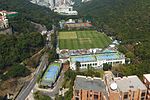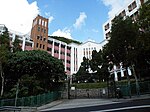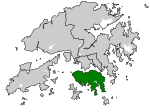Wong Nai Chung Gap
Hong Kong geography stubsUse Hong Kong English from July 2017Wong Nai Chung Gap

Wong Nai Chung Gap (Chinese: 黃泥涌峽; lit. 'The gorge that yellow mud is gushing out of') is a geographic gap in the middle of Hong Kong Island in Hong Kong. The gap is between Mount Nicholson and Jardine's Lookout behind Wong Nai Chung (Happy Valley). Five roads meet at the Gap: Wong Nai Chung Gap Road, Tai Tam Reservoir Road, Repulse Bay Road, Deep Water Bay Road and Black's Link. It is a strategic passage between the north and south of the island, though less so today since the opening of the Aberdeen Tunnel.
Excerpt from the Wikipedia article Wong Nai Chung Gap (License: CC BY-SA 3.0, Authors, Images).Wong Nai Chung Gap
Wong Nai Chung Gap Road, Hong Kong Island Wong Nai Chung Gap (Wan Chai District)
Geographical coordinates (GPS) Address Nearby Places Show on map
Geographical coordinates (GPS)
| Latitude | Longitude |
|---|---|
| N 22.25723 ° | E 114.19245 ° |
Address
黃泥涌峽道 Wong Nai Chung Gap Road
Wong Nai Chung Gap Road
Hong Kong Island, Wong Nai Chung Gap (Wan Chai District)
Hong Kong, China
Open on Google Maps










